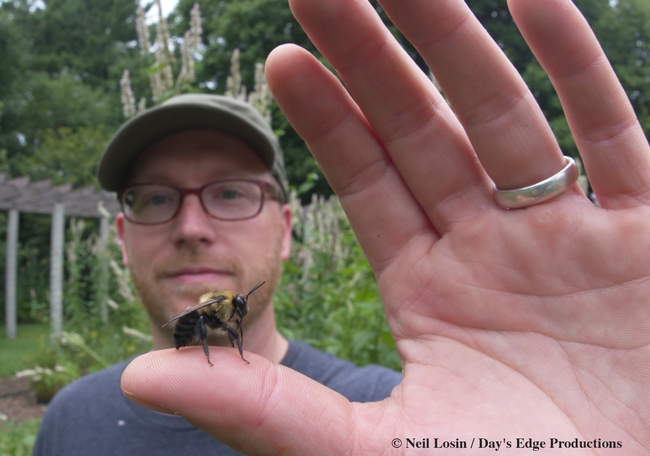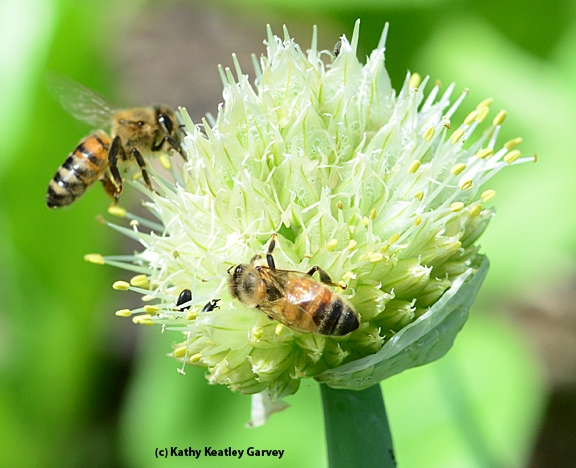Posts Tagged: production
Saving the Rusty-Patched Bumble Bee
Hear that buzz? That's the sound of success. It finally happened. The beleaguered rusty-patched bumble bee, Bombus affinis, is now listed by...

This is a frame from the film, "Ghost in the Making," showing Clay Bolt with the now endangered rusty-patched bumble bee. © Neil Losin / Day's Edge Productions

Noted bumble bee expert Robbin Thorp, distinguished emeritus professor of entomology at UC Davis, helped spearhead the project of getting the rusty-patched bumble bee listed as endangered. Here he's pictured with the critically imperiled Franklin's bumble bee. (Photo by Kathy Keatley Garvey)
Alfalfa and Forage Field Day at KARE in Parlier on September 14, 2016
Join us at the Kearney Agricultural Research and Extension Center for a half day of demonstrations and education on managing pertinent issues in...
Alfalfa and Forage Field Day 2016
Bees and Onions Go Together: Pollination Partners
The University of California, Davis, is a world leader in seed, plant and agricultural sciences. Some 100 seed and seed-related companies are...

Honey bees on an onion umbel. (Photo by Kathy Keatley Garvey)

Honey bees circling the "globe" (onion umbel). (Photo by Kathy Keatley Garvey)
“Greening” up your Valentine’s Day gift
Valentine's Day is one of the most demanding holidays in the cut-flower industry. Consumers struck by Cupid's arrow spend more than $1.9 billion on cut flowers alone. To prepare for the enormous demand for roses, growers produce an estimated 233 million roses, according to an About Flowers research study.
California Growers Making Changes
While many consumers are thinking about love – few are thinking about the impact the cut-flower industry is making on the environment. Since 1990, California has required the agricultural industry to report on all pesticide use, this includes detailed pesticide reporting for the cut flower industry.
Research shows pesticide use in California cut-flower production declined by almost 50 percent from 2001 to 2010. According to a recent UC Division of Agriculture and Natural Resources (UC ANR) article, there are many reasons for the reduction including increased rules and regulations, early pest infestations practices, a new generation of organic growers and increased public awareness.
California cut-flower farmers have vastly improved their pesticide use and policies over the past decade. The state currently produces 60 percent of roses sold in the U.S. each year, but growers simply can't keep up with the Valentine's Day surge in demand during the cold winter months when production slows. These factors contribute to a vast majority of the roses sold in February being imported from Columbia and Ecuador.
Impact of Imported
In a typical year, between 85 percent and 95 percent of the most common fresh cut flowers sold in the U.S. are imported from Colombia or Ecuador, according to an article in One Green Planet. With fewer restrictions on pesticides in South America, the environmental impact of growing roses in these countries can be devastating.
“To cultivate that perfect rose, growers often resort to chemical weed and insect killers,” Alejandro Boada of Universidad Externado de Colombia states in an article in Organic Bouquet. “Pesticides have been found 300 to 400 meters deep in the soils, which have been unable to filter these poisons. Meanwhile, demand for water has also been found to strain local aquifers, on which other farms depend.”
Not only does aggressive pesticide use in these countries have a destructive environmental impact, their fragile imported roses often have to fly thousands of miles to wholesale warehouses and transported in energy-guzzling refrigerated trucks before reaching the flower shop cooler.
Alternatives for Your Valentine
Don't worry, there are plenty of romantic alternatives with a smaller carbon footprint for your Valentine this year!
- Give a native plant. Native plants thrive in your local environment and provide food for pollinators like bees and butterflies.
- Find a local flower grower in your town using The Association of Specialty Cut Flower Growers online U.S. database. Not only are you supporting a small often-times family-based farm, you are investing money back into your local economy.
- Connect with fresh, beautiful, organically raised flowers using an online database from Local Harvest.
- For a food-lover, potted herbs make a great gift.
- Gardeners love collections of seed packets for a bountiful summer harvest garden.
Learn about growing roses for your Valentine in your own garden by joining the UC Master Garden Program in your area.
UC Field Day showcases California’s dry-bean research advancements
California consumers may not “know beans about beans,” but they should.
Dry beans are a big business in California. In 2011, growers harvested 45,000 acres of dry beans valued at $58 million. Lima beans accounted for about 40 percent of this total acreage, with California producing nearly 99 percent of the U.S. domestic supply of dry lima beans.
Why should we be so interested in beans? From a nutritional standpoint, dry beans are a healthy food choice - an excellent source of protein, fiber, vitamins and minerals, plus they’re very low in fat. Organizations such as the American Heart Association, the American Diabetes Association and the USDA’s My Plate all recommend including beans in one’s diet to reduce cholesterol, maintain normal blood sugar and to maintain a healthy weight. The California Dry Bean Advisory Board posts many bean recipes on their website at http://calbeans.org/.
From a production standpoint, beans are a crucial crop for farmers. California growers produce four main classes of dry beans, including limas (large and baby), common beans (such as kidneys, pinks, whites, cranberries and blacks), garbanzos (chickpeas), and cowpeas (blackeye beans). Garbanzo beans are grown as a winter crop, while the others are produced in the summer. California’s dry beans are marketed throughout the world, including Japan, Mexico, Canada, and the United Kingdom. California also grows dry bean seed stock for export to other states and international markets.
In rotation with other crops beans help control weeds, add biomass to the soil via plant matter disked into the ground after harvest, and require relatively few pesticides. In addition, beans, as legumes, fix nitrogen from the air via nitrogen-fixing bacteria that colonize the roots, forming nodules. Cowpeas, for example, fix about 100 pounds of nitrogen per acre, providing most of the nitrogen needs for this crop. Likewise, garbanzo beans require minimal nitrogen inputs for crop production. Economically, beans can enhance the annual farm profitability because common beans and cowpeas can be double-cropped with grains or forage crops, producing two crops in one year.
University of California scientists showcased their dry bean research advancements at the annual UC Dry Bean Field Day, held Sept. 5 at the UC Davis agronomy farm. The event drew more than 50 growers, industry representatives, students, faculty members and UC Cooperative Extension farm advisors.
The participants learned about UC research trials, led by Paul Gepts, professor in the Department of Plant Sciences at UC Davis, focus on dry bean breeding programs for pest and disease resistance, drought tolerance, organic production, and yield and quality increases. “Dry” refers to allowing the beans to fully mature and dry on the plants, as opposed to picking the beans green as a fresh market vegetable.
Many of today’s commercially grown dry beans come from University of California varieties, such as those shown at the UC Field Day. Seed germplasm for different genetic traits are selected from all over the world. The lima bean trial at UC Davis included 56 seed selection entries, the heirloom beans included 25 entries, and cranberries and pink beans had 134 entries. Earlier this year eight advanced line garbanzo entries were tested. UC Davis researchers work with hybrids produced by hand crosses to increase seed yield, quality, pest and disease resistance and plant vigor. They receive funding from a variety of sources including the California Dry Bean Advisory Board and USDA.
As shown from this field day, UC research is leading the way to ensuring that the future of California’s dry bean industry remains strong. These efforts will continue to enhance sustainable farming practices in our state and provide nutritional benefits to consumers.
The bottom line is that beans are good for you. A special treat at the UC Davis Field Day luncheon, served at picnic tables shaded by olive trees on Bee Biology Road, was a locally produced three-bean salad. It vanished within minutes. “Excellent!” the attendees raved.
So, the next time you’re in the produce section of your favorite grocery store, enjoy some California-grown beans. From the field to fork, these beans are the best of the best.
Additional resources:
Blackeye bean production in California, UC ANR publication number 21518.
Common bean production in California, UC ANR publication 8402.

Dry bean field day luncheon at UC Davis. (Photo: Kathy Keatley Garvey)

Bean plant. (Photo: Kathy Keatley Garvey)





